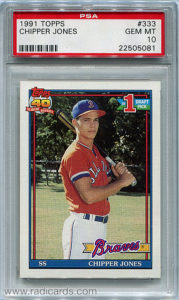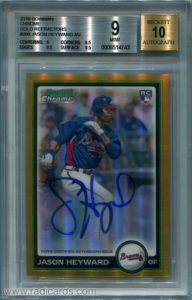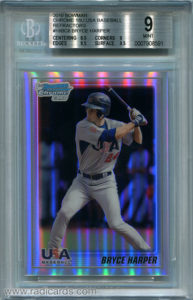
It was a sunny and warm summer day in June 2009 in beautiful Albuquerque NM. There I was, wasting time at my local hobby shop, Derek’s Dugout (RIP). I found myself there often. I used to stop by there on my way to school once a week or so to snag a few gems from Derek’s $1 box. There is something calming about having a stack of baseball cards to review during my study breaks from long hours in my office at school. It’s a refreshing change of pace and it keeps me young. Derek didn’t have just one box though, he had about 20 Super Shoe Boxes broken down by sport. I rifled through the baseball boxes routinely. Aside from my endless search for Frank Thomas cards that I don’t already have, I’m always in search of rookie cards and anything that I don’t often see. You know, those rare but often inexpensive gems that slip through the cracks of recognition and popular demand. Those ones. Maybe I’m feelin’ like an autographed 1991 Upper Deck Eric Karros card or maybe that minor league ProCards Travis Fryman is talking to me. Anything can happen in the dollar bin bank.
One day at the shop, Derek gave me a copy of the Ultimate Rookie Card Encyclopedia. What a useful gift! I really couldn’t believe he gave me this volume valued at $30! Special thanks to Derek for donating a copy and for having a place for me to shop over the years.
Let’s get something straight here before we get down to the nitty gritty of this article. A lot of the confusion about what really constitutes an official rookie card can be chalked up to a misunderstanding between a player’s rookie card and a player’s rookie year. A rookie card is a player’s first appearance on a release from a major brand licensed by MLB and the MLBPA. This appearance may or may not take place on the same year the player appears in his first MLB game. In contrast, a player’s rookie year is the first year the player appears in an MLB game. This could take place years after a rookie card has already been issued for that player. That said, let’s move on to the meat of the discussion.
Sometimes it’s hard to identify a player’s true rookie card. These days, it’s nearly impossible due to players showing up in major brands licensed by MLB sporting USA uniforms long before they ever play a game in The Show with the big boys. Even these aren’t yet considered rookie cards, although, I think they should be. Think about it, name one Stephen Strasburg card that can be found in the price guides that accompanies the RC’ identifier that is his true rookie card. By the time he threw his first pitch with The Washington Nationals in 2010, he had already been featured on Upper Deck releases two years prior.
Since players started showing up in their college uniforms in products like Bowman Chrome, Bowman Sterling, Bowman’s Best, Bowman Draft Picks (well pretty much anything Bowman), Donruss Elite, Topps Pro Debut, Sweet Spots and various Upper Deck products, it makes it difficult to pin down the players official rookie card. Since these players haven’t yet made their pro debut, none of these cards can feasibly carry the ‘RC’ signifier, and as such cannot be true rookie cards. If you go by the definition stated above that the official rookie card is that which depicts the player for the first time on a card by a release that’s produced by a brand licensed by MLB and the MLBPA, than these pre-pro year cards are in fact the player’s true rookie cards. The ‘RC’ designation is typically reserved for cards produced during the player’s first year in professional baseball. But typically, by that time they have already been featured in various releases from years prior. This happens all the time.

Examples include: Dustin Ackley, Buster Posey, Jason Heyward, Bryce Harper and of course, Stephen Strasburg. I can’t really figure out what’s what with these guys. Do they have valid rookie cards? If so, which one’s carry a valid RC signifier in the price guides? This year’s releases featuring these players are considered their rookie cards. But if that’s the case, why do I find Jason Heyward featured in Topps and Bowman products released as far back as 2006? Perhaps the hobby is playing some sort of exhausting and dishonest practical joke on us in hopes of manipulating consumer demand. The scheme seems to play to the tone of: hey, let’s release products today featuring players that haven’t developed yet and/or may or may not be called up but just for a goof we won’t call them rookie cards until they reach potential 2, heck maybe 3 years worth of product down the line. Sound deceiving and illogical enough for you? Yea, I’m confused too.
While I’m being a complete whiner here, I may as well continue with my frustration. Why on earth does there need to be so many different rookie cards of one player? I think Albert Pujols has somewhere in the ballpark of like 49 different rookie cards, and that was 9 years ago! To be honest, I don’t really care to know how many different rookie. cards Stephen Strasburg has or is going to have by year’s end. It’s just overwhelming to even consider trying to track down all of them. That and I have next to no idea which ones are his true rookie cards since I can’t find a single one that features the RC acronym in price guides.
While we’re on topic, can we please put an end to all of the 1952 Topps Mickey Mantle rookie card propaganda? This isn’t his rookie card. Mickey Mantle’s only rookie card is from 1951 Bowman
and let everyone be happy with that.
There is a significant gray area here that needs to be addressed. The very privilege of rookie card production should be put up for auction every year. The company with the most buying power gets to make said player’s rookie card for that year. To make things even more interesting, there should only be a small number of different rookie cards, for the sake of discussion, we’ll call that number 5. Each of the 5 will have a limited but unstated production run, enough with the serial numbering already! The unstated runs will fall to the key of 1000, 500, 100, 10 and 5. They don’t even have to be parallels, just keep the runs modest. That’s 1615 rookie cards of said player. Plenty of opportunities for those cards to be shuffled around on eBay and various auction sites. The number may seem low but that’s 1615 chances to potentially see that card hit the secondary market. It’ll sure strengthen any fading significance the term rookie might still have left and prevent companies from essentially producing lies. A part of me feels like that term is dying if it hasn’t already been buried yet. Everyone’s getting dirty in this muddy situation. I also miss the old logo featured on the Mark McGwire 1987 Donruss #46. An updated version of that classic logo can be found on the Chipper Jones 1993 Donruss #721
. Neither of which are true rookie cards.

Let’s go back even further. 1991 Chipper Jones: Bowman; O-Pee-Chee; Score; Topps, and Upper Deck. These are his true rookie cards. So why on earth was he still being featured in subsets and insert sets well into the mid ’90’s that possess a direct association with the term rookie? with set names like: Future Stars; Rookie Sensations; Wave of the Future; Top Prospects and the like. Some of his cards from ’92 all the way up to ’96 still feature the term Rookie. Is it really necessary or even relevant to associate a player with the rookie designation 5 years into his career?! You can generalize this redundancy with players like Derek Jeter, Alex Rodriguez and many others; even Mark McGwire’s 1987 Donruss carries the Rated Rookie logo but isn’t in fact Mark’s true rookie. I really wish brands would stop doing this because it just misleads and makes collectors sound like a bunch of senseless halfwits when they describe or brag about their collections and which rookie cards they do or don’t possess.
Today’s version of the rookie card simulates something of a reverse scenario of the early ’90’s rookie debacle. While in the early ’90’s, a player’s first card with a major brand was his true rookie but the term was used incessantly on that player’s cards for the next 4-5 years down into his MLB career. Today, a player reaches the major brands and that player might not be associated with the term rookie until 3 years later. I don’t care much for that type of manipulated confusion. Why can’t it just be simple like it used to be 30 years ago, just 1 rookie card?! After that card is released, that’s it, you’re on your own.
Although I don’t find Beckett to be the Bible by any means, the Ultimate Rookie Card Encyclopedia addresses the what’s what issue with rookie cards. No prices here, just cut and dry answers. It’ll be either a slap in the face or a mind easing reassurance. Either way, it’ll clear up a lot of confusion for you. If you’re anything like me, you like to know what you’re buying and what you have. I don’t care much about prices or values per-say as much as I care about statistics, insertion ratios and a player’s true rookie card. This book will help you identify the latter.
To get a copy of the Ultimate Rookie Card Encyclopedia, click here.

 Have you visited our store? Click here.
Have you visited our store? Click here.



I must admit this issue is killing me too. The other day I was looking for a proper Andre Ethier RC and found that he has them in 2005, 2006 as well as 2003. I will have to check out the book you mentioned to find what the “true” rookie card is.
Ahh, yes, the newer cards can be somewhat misleading. RE: Andre Eithier – my advice would be to look for cards depicting him in an Oakland Athletics uniform. Best of luck and thanks for reading! 🙂